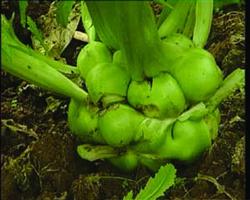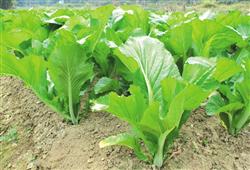How to grow root mustard?
How to grow root mustard? What should I pay attention to? Please guide the planting and management of root mustard can refer to the following methods: (1) during the cultivation season, root mustard is sown in autumn, regardless of north and south. The autumn sowing is earlier in the areas with faster cooling in autumn and severe cold in winter, and later in the areas with slower cooling and less cold in winter. From North China to the Yangtze River basin and the south of the Yangtze River, the sowing date can be from August 5 to September 5, and early sowing is easy to bolting in advance; too late sowing affects yield and quality because of insufficient vegetative growth in the early stage, and the harvest in the colder area has been frozen. The growing season in northeast and other alpine regions is too short and there are many rows of spring sowing. (2) the root mustard of sowing seedlings can be directly seeded, and seedlings are mainly raised in the Yangtze River basin. The fleshy root of direct seeder has fewer branches and neat shape, while the transplanter has more branches, but it is more convenient for centralized management and can make full use of land. In order to reduce the branches of fleshy roots, the methods of soil and early transplanting can be used. During the direct broadcast, when the soil is dry, dig a hole 2 cm deep to sow, cover the soil and irrigate after sowing. When the soil is wet, do not dig holes, sow according to the distance between rows and plants, and rake the seeds into the soil after sowing. The sowing rate is about 1500 grams per hectare. The seeds of root mustard are small, and the soil cover should not be too deep. Seedlings from the direct seeding room can also be transplanted to Honda. The nursery bed should choose loam with good water conservation and fertilizer conservation, plough 20 cm deep before sowing, apply 37500 kg of organic fertilizer, 600kg of calcium superphosphate and 3000 kg of plant ash as base fertilizer before sowing, and make a high border with 130cm wide and 15cm high before sowing. Sowing seeds of 4.5-6 kg per hectare can be planted for 15 hectares of Honda. After sowing, cover with sifted compost to the extent that there are no seeds, then water it, and cover straw to prevent heavy rain and drought. Remove the mulch in time after emergence. When the true leaves are 2-3 pieces and 3-4 pieces, the seedlings should be separated from each other once, and the seedlings with fine and weak seedlings and the inferior seedlings with diseased insects should be removed. After the seedlings, thin liquid fertilizer was applied to control aphids for 3 times. The cultivation of robust, disease-free and compact seedlings is the basis of high yield and high quality. (3) soil preparation and planting root mustard are not strict to the soil, but it is better to use the clay loam which is rich in organic matter to conserve water and fertilizer. Although root mustard likes the humid environment, it is cultivated on the soil with high groundwater level, the fleshy root grows poorly, the water content is high, and the processing quality is poor, so the plot with good drainage and ventilation should be selected. Before planting, the cultivated land is 20-30 cm deep, 1.5-2 m wide and 15 cm high. According to the degree of development of the variety, the row spacing is 37-47 cm, the plant spacing is 33-40 cm, generally planting 45000-52500 plants per hectare. If the planting is too dense, the fleshy root is not suitable for processing if it is less than 250 grams. The seedlings were about 30 days old and about 5 true leaves were planted, and slightly inflated fleshy roots could be seen at that time. Watering before planting, in order to take the soil to take seedlings, planting, the seedling straight root perpendicular to the center of the planting hole, burying the soil should not exceed the shortened stem, so that the root is not distorted, not damaged, the future fleshy root can grow neatly, less branched root. Root mustard requires plenty of fertilizer. Because the fleshy root is the main product, fertilization should not only benefit the growth of leaves and roots, but also cooperate with the application of phosphorus and potassium fertilizer. Base fertilizer per hectare compost 37500 kg, calcium superphosphate 600kg, plant ash 3000 kg or potassium chloride 300kg. (4) the topdressing of root mustard in field management shall be carried out according to the principle of light, heavy and light. For the first time, 15000 kg of thin animal manure and 75 kg of urea were applied per hectare after survival or direct seeding to promote the formation of strong leaf clusters. For the second time, when the leaves and fleshy roots grew rapidly, the thicker animal dung water was 15000 kg plus urea 225kg, and the fertilization time was about the end of October. The third time to see the seedling growth is appropriate to apply thicker animal dung, if the growth is very prosperous, can no longer apply fertilizer. Share 4000-5000 kg of animal manure for 3 times. Topdressing was applied one month before harvest. The budding, bolting and flowering of root mustard have no strict requirements for low temperature, and early bolting often occurs before the year. Especially early-maturing varieties are prone to early bolting, which affects the yield and quality of fleshy roots, so we should pick the heart as soon as possible, erase the flower bud or cut the flower stem near the base with a sharp knife, and the incision is slightly inclined to prevent stagnant water from rotting. If the heart is picked too late, it will affect the quality of processed products. (5) to harvest root mustard in areas with heavy frost in winter, they cannot overwinter in the open field, but must be harvested before the frost. In North China, it is cold in winter, sowing early in autumn, and the total growth period is relatively short, usually only about 90 days, which should be harvested from late October to early and middle November. In warmer areas such as Yunnan and Sichuan, the growth period of early-maturing varieties is about 120 days, that of middle-maturing varieties is about 130 days, and that of late-maturing varieties is about 140-150 days. Generally speaking, the suitable harvest time is from late December to early and middle January. The sign of maturity is that the basal leaves are orange, the root head changes from green to yellow, and lateral branches or buds appear between the axils of the leaves, which should be harvested in time. After harvest, the epidermis thickens, the fiber increases, bolting or hollow, which affects the processing quality. After digging up the fleshy root, cut off the lateral root, cut off all the leaves according to the processing needs, or leave a few green leaves, and then deal with them according to the processing needs. The average yield is about 30000 kilograms per hectare. Click to get more mustard planting techniques click to get more vegetable planting techniques
- Prev

How to fertilize the root with mustard?
How to fertilize the root with mustard? Please introduce the method of root mustard fertilization can refer to the following methods: 1. The application of basic fertilizer root mustard like the land rich in organic matter, so be sure to apply a sufficient amount of organic fertilizer before soil preparation, generally can use farm manure or pile of municipal waste, and then add plant ash and over.
- Next

How to grow mustard in winter?
How to grow mustard in winter? Please give an introduction to big mustard, also known as heart mustard, meat mustard, cruciferous, long-day crops, like cold, humid climate conditions, but not frost resistance. Its meat is thick, sweet and delicious, can be fried with meat, especially suitable for processing such as pickled cabbage, the product taste...
Related
- Where is it suitable to grow horseradish in China? it is expected to see the middle altitude horseradish in Alishan.
- How to prevent tomato virus disease reasonably? (Control methods included)
- Many people like to plant towel gourd on the balcony. What are the main points of this method and management?
- What crops can chili peppers be mixed with?
- Fertilization techniques and matters needing attention in Tomato
- What are the grafting techniques for peach seedlings in spring?
- Harm and control methods of root swelling disease of Chinese cabbage
- What are the pests of sweet potatoes? How to prevent and cure it?
- Symptoms, causes and Control methods of navel Rot in Tomato
- The cause of "Cucumber rotten bibcock" in Farmers' planting Cucumber and its Control Plan

